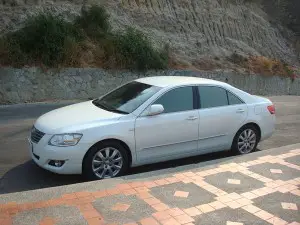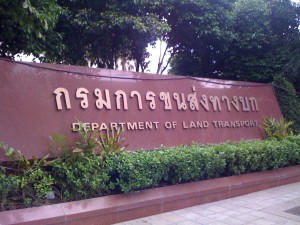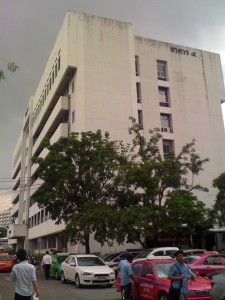You come to Thailand on a three-week holiday, taking advantage of one of those cheap holiday deals, fall in love with the place and its people, and decide to move (un)definitely to the Land of Smiles. Your skin is white enough to secure you a job teaching hordes of Thai students the English language (it doesn’t matter that grammar rules make no sense to you!) and, on the side, you’ve opened the one thousandth eBay business, selling Thai kitsch to believers in the Western world.
At first, the recklessness of the tuk-tuk drivers and the death defying zigzagging of the motorcycle taxis during Bangkok rush hour thrills you. But once you see with your own eyes a few dead bodies (not the pixeled out pictures on the front page of Thai newspapers), innocent victims of insane bus drivers or drunk driving, you know that the 200 baht helmet you bought from Carrefour will not save your life. Next time it might be your motorcycle taxi driver who squeezes between two buses, grazing your knees on the bus wheels and subsequently losing control of his bike, with both of you ending up just another casualty in the oh-so-normal game of life-and-death on the roads of Bangkok.
So, what to do? You decide to take your destiny in your own hands. First, you buy a good life insurance – so that your Thai girlfriend can bury you in style and be at peace that your ghost won’t be haunting her forever – and then, depending on how much money you’ve saved (or more accurately, you’ve spent) since you’ve moved to Thailand, you buy a small city bike or even dish out a couple of tens of thousands of baht for a down payment on a car.
Of course you have a driving license from back home (which luckily hasn’t expired, yet) and thus you hit the roads, remembering to be careful and not end up just another road traffic casualty statistic. Things are pretty smooth for you, gasoline is not that expensive for your farang salary (or you even changed your car engine to LPG), your lady loves it, and you get to drive out of town at the weekends. But something keeps bothering you: almost every month, the traffic cops stop you and, true to the Thai law, you end up paying a fine (or part of the fine…) because you’ve been in the country for more than three months and you should have replaced your national driving license with a Thai one.
One day, you finally do it. You take the English-language Thai driving license test, remain baffled at the grammar in the questions, the illogical answers, the questions with no correct answer, or having to choose between a), b) or c), but only answer a) is displayed on the screen. Obviously you fail, but you know the right people and, with some help, you get your Thai driving license. Finally, you’re legal.
Fast forward one year later and you’re still alive, you’ve had only a few minor accidents, but no one got hurt and the insurance took care of the damage. Then, one night, at a random roadblock in downtown Bangkok, an army of cops pulls you over and asks for your driving license. Luckily, you haven’t been drinking so, really, there’s no need to sweat. Just another crackdown on ya ba trafficking, you think. But, to your shock, you see the brown-clad cop taking out his booklet and starting to write a fine.
“Is there a problem?” you mutter in a farang-accented Thai.
The reply comes like a freight train smashing into your car at full speed: “You license aiu mot leow. Expire leow.”
You muster all your neurons to work towards comprehending what the cop is saying and you finally get it. It’s been a year since you’ve had your Thai driving license issued and you’ve forgotten to renew it!
You try to “reason” with the police officer, but they’re on a mission tonight and not interested in your “donation” so, you say good-bye to your Thai driving license as you swap it for the fine ticket. You’re lucky enough to live in the area and thus the police station where you go the next day to pay the fine and pick up your driving license which is not that far. But, you start panicking as your license has expired and “What if they say I can’t renew it because it has expired for too long and I have to sit the test once again?”
The next day you take a day off from work (or just call in sick – as Thai employers seem to think that farangs have no need for personal days off!) and, the night before, you Google the internet for information regarding the renewal process. You get confused with the different opinions posted on blogs, forums and copy-and-paste websites. So, you prepare all the possible documents – just in case – and go to bed in peace, knowing that you have everything you need:
- signed copy of your passport’s photo page;
- signed copy of your non-immigrant visa and the last stamp from the Thai Immigration Bureau;
- signed copy of your work permit (which replaces the letter of residence issued by your embassy);
- two recent 1-inch photographs;
- the expired Thai driving license.
You also make a mental note to stop on your way to the Department of Land Transport (DLT) headquarters office on Phahon Yothin Road (between Saphan Khwai and Mo Chit BTS stations), at a clinic and get a medical certificate. Don’t, you don’t need it for renewals!
You can also renew your driving license at smaller DLT offices in your district area. The best way to get there is to rent a motorcycle taxi driver from your neighbourhood. They will know for sure where to take you. Whatever the location, try to be there early in the morning and avoid lunch-time hours when any public office in Thailand gets pretty crowded.
The next morning you park your vehicle in the crowded compound of the DLT headquarters and make your way to Building 4. It is one of the many white buildings that litter the compound and, in case you can’t read Thai, look for this sign “๔” – which is the numeral 4 in Thai script – displayed in black on the building. The DLT is offering a one-stop service here, so the application process will start and finish in the same building, saving you the trouble of running from one place to another in its huge complex.
Once inside, don’t waste your time at the ground floor reception booth, but go straight to the second floor where your documents will be checked and your application will be processed. In case you have two Thai driving licenses (one for motorcycles and one for cars), you’ll need all the documents listed above in duplicates. I know, it’s a waste of trees and I wonder when Thailand will cut down on its bureaucracy and smoothen the lives of people living here?
You will definitely stand out from the crowd – white, big, sweaty, and loud – and your application will immediately catch the attention of the floor supervisor who will remind the students on practice at the counter that there are two special booths (no. 17 and no. 18) reserved for foreigners. These not only are manned by English-speaking staff, they also have a separate queue number system. This is a big bonus for you because the waiting line at these booths is usually short, with just a few Asian students and labourers making its ranks.
Once your turn is up, the “officer” in the booth collects all your documents, takes a digital photograph of you, and then gives you a form which you will have to take to the third floor. Here, in a large room, there are three stations you’ll have to pass to get the required stamps and signatures on your form. The first one is a traffic lights colour test. Basically, you have to tell the lady operating a “traffic light” what colour is on. Don’t expect her to know the colours in English, so you’d better remember that, in Thai, red is daeng, yellow is luang, and green is khiaw.
Once you’ve passed the colour test, you move on to a more entertaining station: brake reaction time. Although you might need some explanations to what you actually have to do, the lady supervising the test can’t speak a word of English. When my turn came up, I said, “Khun sa mat sa daeng dai reu mai?” which means “Can you show me?” and pointed at the device. What one man can do, another can do, so I gave it a try. There are two pedals which you have to operate with your feet while seated. A green light shown in front of you means you have to press the “acceleration pedal” all the way down. Then, a few seconds later, the lady in charge changes the light to red and you have to hit the “brake pedal.” Your reaction time is shown on the display console as a vertical line of lights. If you’re too slow, the light will light all the way up from green to red. Obviously, the idea is the keep the vertical lights on green only. You get to try this station a few times and I’ve seen some of the older Thais get their form signed even if the red light limit was lit up by a few notches.
The third and last test is probably the most interesting one, which may actually tell you something you don’t know about yourself. It tests your peripheral vision up close, which means they want to know how well you can see close-up objects to the side while looking straight ahead.
All three stations are in everyone’s view, so placing envelopes in pockets in case you fail one of the tests might be a bit difficult. Still, the tests are not that strict and you are given enough opportunities to get it right.
Then, you’re sent to the fourth floor where, alongside your form, you need to hand in your passport too. You wait for your turn for the “movie room,” where you will be shown three movies. The first one is an animated presentation of the main traffic rules (all in Thai!), followed by a shocking compilation of road accidents – mainly caused by motorists who ignored the red traffic light. Literally, you’ll see bodies flying in slow motion across intersections, motorbikes disappearing under 12-wheel trucks, and bicycles ending up on the windshield of cars coming from the opposite direction. I think both videos made their point and, for Thailand, they seem to have served their purpose.
What baffled me – bordering the unbelievable – was the last 30-minute soap opera-like production about two Thai families and the consequences of reckless driving in comparison to motorists who respect traffic rules. It has English subtitles and, although the grammar is perfect, half of the time you can’t read the text as the background is very bright (a shadowed border would have helped immensely). If the movie had been ten times shorter and hadn’t been flawed, this article would have also been one paragraph shorter, but unfortunately, it wasn’t so.
For a movie shown in the building of the Department of Land Transport with the intention of being played to a bunch of bored people who only wanted to renew their driving license and get on with their lives, the movie was a total failure. I’m not referring here to the quality of actors. No, there were other major problems with the picture. How about children standing in the back seat of a moving car (as opposed to sitting with their seatbelts on); driving with just one hand on the steering wheel; parking on the sidewalk (typical Thai-style); kids riding in the front seat (a big no-no in Western countries); getting driving lessons from an unauthorized instructor in an unmarked vehicle; drivers not wearing a seatbelt (!!!); and learning to drive a car in a moo baan, a Thai housing compound.
Towards the end of the movie, a lady encouraged the viewers to buy a 50-baht booklet about… something to do with driving. I was surprised to see quite a few people purchasing it. Once the movie was over, the Thais collected their forms and ID cards from a table nearby. I was pleasantly surprised to see that my passport was not placed on the table in the open for anyone to just take it, but was handed to me personally by one of the ladies working on this floor.
With all boxes signed and stamped, I went back to booth 17 (or 18) on the second floor to pick up my brand new, 5-year valid Thai driving license. It comes as a plastic card, with basic information (including the expiry date!) in English and images of the kind of vehicles you’re allowed to drive. It struck me as inefficient once again how I received two almost identical cards, one for motorcycles and one for cars. There was enough space on any of the cards to squeeze in one more word and one more image! The costs were a bit higher than the last time when I renewed my driving license five years ago, but they’re still affordable: 305 baht for motorcycles and 555 baht for cars.
In conclusion, apart from the failed attempt at educating motorists with a terribly flawed motion picture, I left the headquarters of the Department of Land Transport in Bangkok pleased with their one-stop service. In total, I spent less than two hours going up and down the stairs to the various test places. Two hours for five years worth of driving and the knowledge that “you’re legal” was definitely worth the trouble. Now all I, you, and everybody else behind a wheel or on the saddle need to do is stay in our lane (for God’s sake, stop changing lanes every ten meters!), respect the traffic lights, and watch our speed. Basically, take it easy. It’s better to arrive at your destination later than never. Stay cool. Jai yen yen. God’s speed.





Hello,
I went to the DLT on Phahonyothin today 1st March 2012 and would like to update you on the renewals procedure. This was for a 5y motorbike licence, do not know if the car licence will be the same.
Firstly, you DO require a medical certificate for a renewal but you no longer need the 1″ photos. Copies of other documents required as you described.
You are supposed to present your documents at the reception on the 2nd floor and get a queue number. Then off to booth 17 or 18. Your documents will be processed and you get the paper to go to the 3rd floor for the 3 physical tests – colours, reactions and peripheral vision – as described. You are no longer required to sit through the videos so back down to booth 17 or 18 on the 2nd floor. Pay your money, get your photo taken and you have your licence. I reckon you could get through the whole process in less than 30 minutes.
I did not get a queue number from reception since I did not have a medical certificate. I sneaked through to booth 18 anyway to try my luck. The lady there kindly let me proceed but said that I should get a medical certificate after completing the 3 physical tests. I still got through everything in just over 1 hour and this included a ride by mc taxi to a clinic on Sutthisan and back.
Overall, a very pleasant experience.
Cheers.
Thanks for the update!
Greetings,
As of 25 Apr 12 all the above is still correct. I did have to make a copy of my American DL and made two copies for 4 baht 10 meters from where you queue up to get your number at second floor information. I did a five-year renewal of my Thai auto DL and my first Thai motorcycle DL. I have a work permit and all went smoothly. I’m color blind and tried to fail the peripheral vision test. They didn’t make us line up the two sticks this time around for depth perception. I arrived at 9:15 a.m. and was out in about exactly an hour.
Nothing at the facility appears to set-up in English from building name to documents. However, I bumbled through without any problems with the above knowledge in hand. It was not a horrible experience.
5-year auto was 655 THB and 1-year motorcycle was 155 THB.
I had only a single original of my medical certificate and a copy with my signature – they accepted this without any problem.
This was done at the office 5 minutes south of Mo Chit. It was as smooth of an operation as I’ve been through in Thailand. I assume it would have taken a little less time if I’d managed to get there 30 minutes earlier, but it still wasn’t bad.
Cheers.
I’m glad to hear it went smoothly.